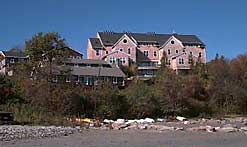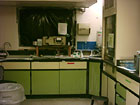

 | |||||||||||||
|
|
Journals 2005/2006Christine Leavor
August 9, 2005 Well, I made it from the Haddie Pierce to URI without any problems. It's actually only a seven-mile drive. I even found Dave's office again, all by myself. He's tucked away in this little corner of the building where room numbers are in the one-teens, and all of a sudden, out of nowhere, is a room 130. It must have been a cruel joke on the part of whoever designed the building. Dave explained that we would not be moving equipment to the R/V Cap'n Bert today because he has some deadlines to meet for some proposals he is writing. We will meet tomorrow morning to load and move the equipment prior to our voyage. In the meantime, today I will be working with Kelly Henry in the lab. Dave told me that he'd nail down the actual time to meet tomorrow, and either stop in to see Kelly and me, or email us with the time. So, armed with Kelly's office number, I walked across the street to the Coastal Institute, which is where we had our ARMADA orientation in June. While on my way up to the third floor, where Kelly's office is located, I met up with Jill Johnen, the ARMADA Project Science Director. Since she had never met Kelly either, she accompanied me up to Kelly's office.
After introductions, Kelly, a graduate student at the University, explained that we would be conducting chlorophyll tests on samples that had been collected on a previous excursion. She said that it is sort of backward- seeing the end of the testing before seeing how the samples are collected- but assured me it would all make sense after the next couple of days. (If she says so....)
We walked across the street and down the hill to a smaller building that housed the chlorophyll-testing lab. She patiently explained the overall process and the equipment we would be using. Water samples have already been filtered through small round fiber filters. These filters were placed in plastic centrifuge tubes with acetone and refrigerated for 24 hours. When the water is filtered, not only phytoplankton is filtered onto the patches, but zooplankton and oceanic debris as well. Since we want to measure chlorophyll, we are interested in the phytoplankton. The acetone separates the phytoplankton from the other materials. The tubes then are placed in a centrifuge to push the filters down into the bottom of the tube so we can decant the acetone liquid into test tubes. The test tubes are put in the fluorometer. This measures the luminescence of the chlorophyll. Kelly explained how to read the meter on the fluorometer. This can be tricky because there are four different scales to choose from. At each testing site, Kelly took two samples each from the surface and bottom of the water. She does a reading from each sample and carefully records the results. Then two drops of hydrochloric acid are added to each sample. The first reading measures both living and dead organisms. The acid removes the living organisms, leaving only the dead. There is a complex chart to decipher all this information. After the procedure was explained, we set to work. It was then that Kelly told that since chlorophyll is light sensitive we needed to work in low light, similar to being in a photographic dark room. My eyes are old, but we donned our gloves and went to work. My job was to put the tubes in the centrifuge and then decant the vials into the test tubes, carefully wiping the outside of each tube to remove fingerprints and any spilled acetone. After Kelly recorded the readings, I added the acid and then put the empty centrifuge tubes back in their boxes, being careful to keep the numbers in order. Kelly began her test by running a "standard" which is similar to what we call the "control" in the classroom. It is a pre-tested vial against which to check the accuracy of the fluorometer. She would continue to check against this standard after every four readings. We completed 40 of the 58 samples before breaking for lunch. Kelly said the work went much faster with two of us working. It made me feel good to think I had actually been of some help. And, I only mixed up the order of the vials once... Kelly was able to sort it out and thankfully, no harm was done.
After lunch, we finished the testing and washed down all the tubes for tomorrow's samples. We walked over to Dave's office and confirmed tomorrow's schedule. We'll meet at 7:30 at the University to load the trucks and go up to the harbor. Dave said we should be on the water around 10:30AM. Kelly took me to check that all the materials we would need on the water were ready to go and then we called it a "day." She assured me that tomorrow will be a much longer day, so I took advantage of the afternoon by finding the closest Curves and fitting in a workout. |
||||||||||||


